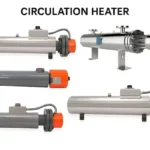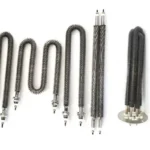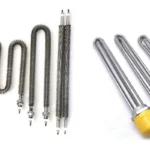This article covers the various types of oven heating elements, their applications, common issues that may arise, and how to maintain them. Understanding the different types of heating elements, how they work, and how to care for them can greatly improve your oven’s performance and lifespan.
Table of Contents
Introduction to Oven Heating Element
What is an oven heating element?
Oven heating elements are essential components in both residential and commercial ovens, providing the heat required for cooking, baking, and roasting. These elements work by converting electrical energy or gas into heat, which is then distributed throughout the oven to cook food efficiently and evenly. Depending on the type of oven, heating elements come in various forms, including electric, gas, infrared, and more, each offering unique advantages.
Types of Oven Heating Elements
| Type | Description | Applications | Advantages |
|---|---|---|---|
| Tubular Heating Elements | Metal tubes with internal resistance wires, often filled with magnesium oxide for insulation and heat conduction. | Used in industrial ovens, home ovens, and commercial baking equipment. | High durability, uniform heating, customizable shapes. |
| Infrared Heating Elements | Emit heat in the form of infrared radiation, typically using quartz or ceramic materials. | Ideal for quick baking, grilling, and applications requiring direct heat transfer. | Energy efficient, fast response time. |
| Coil Heating Elements | Bare metal coils that heat up through electrical resistance. | Found in basic ovens and budget models. | Simple design, cost-effective. |
| Ceramic Heating Elements | Made of ceramic material, often combined with metal alloys for enhanced performance. | Used in convection ovens and high-temperature applications. | Excellent heat retention, efficient energy use. |
| Glass Heating Elements | Glass-based materials with embedded conductive coatings. | Seen in specialty ovens and advanced industrial applications. | Aesthetic appeal, even heat distribution. |
| Halogen Heating Elements | Use halogen gas and tungsten filaments to generate radiant heat. | Common in countertop and convection ovens. | Instant heat, bright visibility for cooking. |
Factors to Consider for Heating Element Selection
Oven Type
- The type of oven, whether it’s a convection oven, deck oven, or refrigerated oven, determines the compatibility of the heating element.
Temperature Requirements
- High-temperature ovens need robust heating elements like tubular designs, while standard electric ovens work well with nichrome-based elements.
Heat Distribution
- Uniform cooking relies on the heating element’s design and placement. For example, the bottom heating element for ovens critical for balanced heat flow in electric ovens.
Regulatory Compliance
- Oven heating elements must comply with various international, European, and U.S. standards to ensure safety and efficiency. Key standards include IEC 60335-2-6 and EN 60335-2-6 for safety in cooking appliances, UL 858 for electrical safety in household ranges, and NFPA 86 for guidelines on ovens and furnaces.
How Does an Heating Element Work?
The heating element in an oven works by converting electrical energy into heat through a process known as resistance heating. When the oven is powered on, electricity flows through the heating element, which has a high resistance to electrical flow. This resistance generates heat, which is then transferred to the air inside the oven, raising its temperature. The oven’s thermostat monitors the temperature and adjusts the flow of electricity to maintain the desired heat level.
Ovens typically use two main types of heating elements: the upper broil element and the lower bake element. The broil element, located at the top of the oven, is used for high-temperature cooking, such as browning or crisping the food. The bake element, positioned at the bottom, generates most of the heat for baking and ensures even cooking. In convection ovens, a fan circulates the hot air generated by the heating elements around the food for even cooking.
Types of Oven Heating Elements for Different Oven Brands
Different oven brands use specific types of heating elements that are tailored to their models, ensuring optimal performance and efficiency. Here’s an overview of the types of oven heating elements used by various brands:
Whirlpool Oven Heating Element
Whirlpool ovens typically use coil heating elements for both baking and broiling. The Whirlpool oven heating element is designed with a high-quality metal alloy, often made from materials like nickel-chromium, to ensure fast and even heat distribution. These elements are suitable for both conventional and convection ovens, providing users with consistent cooking results.
Kenmore Oven Heating Element
Kenmore oven heating elements are available in both coil and flat designs, depending on the oven model. Coil elements are most commonly found in older models, while newer models use solid or tubular heating elements for better heat retention and energy efficiency. Kenmore also offers self-cleaning oven heating elements, which are made to withstand higher temperatures for extended periods, making them ideal for intensive use.
Maytag Oven Heating Element
Maytag ovens often feature heavy-duty coil elements or flat, spiral heating elements that are designed to last longer and provide even heat. These heating elements are known for their durability and ability to maintain consistent temperatures for large meals. Maytag also uses convection heating elements in some of their high-end models, which help to evenly circulate heat and reduce cooking times.
Frigidaire Oven Heating Element
Frigidaire oven heating elements typically include both coil and tubular elements depending on the model. The coil elements are commonly used in older models, while tubular heating elements are preferred in newer designs for more efficient heat transfer. Frigidaire’s convection oven heating elements are designed to provide uniform heat distribution by circulating air around the food, ensuring even cooking results.
Market Trends and Forecast for Oven Heating Elements
 Global Market Size and Growth
Global Market Size and Growth
The global oven market is projected to grow from USD 3,128 million in 2024 to USD 4,516.89 million by 2032, expanding at a compound annual growth rate (CAGR) of 4.70% during this period.
Specifically, the tubular heating elements market, a significant segment within oven heating components, was valued at USD 1.23 billion in 2024 and is expected to reach USD 1.51 billion by 2031, growing at a CAGR of 2.60%.
Energy-Efficient Heating Elements
There is a growing emphasis on energy-efficient heating solutions, driven by increasing energy costs and environmental concerns.
Manufacturers are focusing on developing heating elements that offer improved energy efficiency and performance.
This trend is evident in the industrial electric heating element market, which is projected to reach USD 4.5 billion by 2032, exhibiting a CAGR of 5.3% from 2024 to 2032.
Future Trends
The future of oven heating elements is expected to be shaped by several key trends:
- Smart Technology Integration: The incorporation of Internet of Things technology into ovens is anticipated to enhance functionality and user experience.
- Advanced Materials: Ongoing research into new materials aims to improve the durability and efficiency of heating elements.
- Sustainability: There is an increasing focus on developing eco-friendly heating solutions to meet environmental regulations and consumer demand for sustainable products.
Are You Looking for an Oven Heating Element Manufacturer?
Partner with ELEKHEAT and join our global network of distributors and collaborators. With over 20 years of expertise, ELEKHEAT operates a 48,000-square-meter factory equipped with cutting-edge technology to produce premium oven heating elements, including tubular heaters, finned heaters, and flexible heating films. Our advanced production capacity ensures consistent quality and fast delivery to meet your business needs.
Why Choose ELEKHEAT?
- Global Reach: Trusted by clients in over 40 countries, including markets across Asia, Europe, and the Americas.
- Custom Solutions: Tailored designs to match your specific requirements.
- Free Samples: Test our products to ensure they meet your standards before bulk purchasing.
- Fast Production & Delivery: Efficient processes guarantee delivery within 3–10 days, even for custom orders.
- Expert Support: Benefit from our professional consultation to select the best solutions for your business.
Grow your business with ELEKHEAT’s reliable heating solutions and exceptional service. Contact us today to request a sample, discuss your needs, or explore partnership opportunities!
Copper vs. Stainless Steel Heating Elements: Which Is Better?
When selecting heating elements for ovens, copper and stainless steel are the two most common materials used, each offering unique advantages and disadvantages. Below is a comparison of both materials.
| Feature | Copper Heating Elements | Stainless Steel Heating Elements |
| Conductivity | High conductivity, heats up quickly and distributes heat efficiently. | Lower conductivity, may take longer to heat up. |
| Energy Efficiency | More energy-efficient due to rapid heating. | Slightly less energy-efficient, may consume more energy. |
| Durability | Highly resistant to high temperatures, but prone to corrosion. | Extremely durable, resistant to corrosion and rust. |
| Cost | More expensive than stainless steel. | More affordable, cost-effective option. |
| Maintenance | Requires maintenance to prevent corrosion and tarnishing. | Easy to maintain, does not tarnish or discolor. |
| Aesthetic | Can tarnish over time, affecting appearance. | Maintains a cleaner appearance with minimal upkeep. |
Common Causes of Oven Heating Element Failure
The oven heating element is a vital component responsible for generating heat, and its failure can lead to a range of cooking issues. Understanding the common causes of heating element failure can help in troubleshooting and preventing further damage.
Why Does the Heating Element in an Electric Oven Pop?
The heating element in an oven may “pop” due to sudden changes in temperature or physical damage. A rapid heating and cooling cycle, like turning the oven on and off quickly, can cause the metal to expand and contract, leading to stress fractures or breaks. Additionally, a buildup of moisture or grease on the heating element can cause popping sounds when the moisture evaporates or when it reacts with the heating surface.
Top Reasons for Heating Element Failure
Electrical Issues: Electrical problems are one of the most common causes of heating element failure. Issues such as a blown fuse, tripped circuit breaker, or faulty wiring can prevent the heating element in an oven from receiving power. A malfunctioning thermostat or control board may also prevent the oven from properly regulating temperature, leading to inefficient heating or complete failure.
Physical Damage or Wear and Tear: Over time, heating elements can suffer from physical damage due to frequent heating cycles, especially in high-use ovens. Cracks, burns, or frayed wires on the heating oven element can cause it to malfunction. Prolonged exposure to high temperatures and the constant expansion and contraction of the metal material contribute to wear and tear.
Oven Panel and Heating Element Not Working Together: In some cases, the oven panel and heating element may not work together effectively. This issue could arise if there’s a malfunction in the control panel, which is unable to send the correct voltage to the element heater oven. Troubleshooting tips include checking the electrical connections and ensuring the control board or thermostat is functioning properly.
Warning Signs of a Failing Heating Element
Uneven Cooking: A failing heating element may cause uneven cooking, with some parts of the food being overcooked while others remain undercooked. This is a sign of inadequate heat distribution.
No Heat: If the oven turns on but doesn’t produce any heat, it’s a clear indication that the heating element on oven has failed. This could be due to a broken element or a problem with the electrical connections.
Visible Damage: Signs of physical damage, such as cracks, discoloration, or burns on the heating element, are often visible. If you notice any of these issues, it’s time to replace the oven heating element.
Strange Noises or Smells: A malfunctioning heating element may emit unusual sounds like popping or crackling. It may also produce burning smells, indicating overheating or an electrical issue.
If you encounter any of these warning signs, addressing the problem promptly can prevent further damage and restore the oven’s functionality. Regular maintenance and timely replacements of faulty elements are key to ensuring reliable and efficient oven operation.
Oven Heating Element Replacement Guide and Maintenance Tips
Replacing the heating element in an oven is a straightforward task if done properly. Here’s a simplified guide along with some maintenance tips to extend the life of your heating element.
Step-by-Step Guide to Replacing an Oven Heating Element
 Tools You’ll Need
Tools You’ll Need
Screwdrivers (Phillips and flathead)
Pliers (to disconnect wires)
Multimeter (for checking electrical connections)
Replacement heating element (make sure it fits your oven model)
Unplug the oven to prevent electrical shock. If it’s hardwired, turn off the circuit breaker.
For gas ovens, shut off the gas supply.
Remove the Old Heating Element
- Open the oven door and locate the heating element (typically at the top or bottom).
- Unscrew the screws holding the element in place and carefully disconnect the electrical wires.
- For gas ovens, remove the bottom panel and disconnect the igniter.
Install the New Heating Element
- Attach the wires to the new heating element, ensuring they’re secure.
- Fit the new element into place and screw it back in.
- For gas ovens, install the new igniter and screw it in.
Test the New Element
- Plug the oven back in or turn on the circuit breaker.
- Turn on the oven and check if the new heating element heats up properly. It should glow red. For gas ovens, turn on the gas supply and check that the igniter works.
- Maintenance Tips to Extend the Life of Your Oven Heating Element
Clean Regularly
- Clean the oven and heating element to remove grease and food buildup. Use a soft cloth and non-abrasive cleaner.
- Check for crumbs or dust near the element and clean them gently.
Avoid Overheating
- Don’t overload the oven, as this can block heat and stress the element.
- Avoid keeping the oven at high temperatures for long periods.
Check for Damage
- Periodically check the heating element on oven for cracks or discoloration.
- Ensure the electrical connections are tight and clean.
FAQs
- How do I know if my oven heating element needs replacement?
Look for signs like uneven heating, no heat, visible damage, or unusual smells or noises. - Why does my heating element on oven keep failing?
Frequent failures can result from overheating, electrical surges, or poor-quality elements. Regular maintenance can help prevent this. - Are tubular heating elements suitable for all ovens?
Tubular elements work for most ovens but check your oven’s manual to ensure compatibility. - Can I use a Whirlpool oven heating element in a Kenmore oven?
Some elements may fit, but always check the specifications or ask a professional. - What should I do if my oven heating element replacement doesn’t work?
Ensure proper installation, check wiring connections, and test the thermostat. If it still doesn’t work, consult a technician.
Conclusion
Selecting the right oven heating element is crucial for achieving reliable, energy-efficient cooking. Regular maintenance, timely replacements, and understanding the specific requirements of your oven can extend the lifespan of these critical components. With advancements in materials and smart technologies, oven heating elements continue to evolve, offering better performance and sustainability for modern kitchens.













